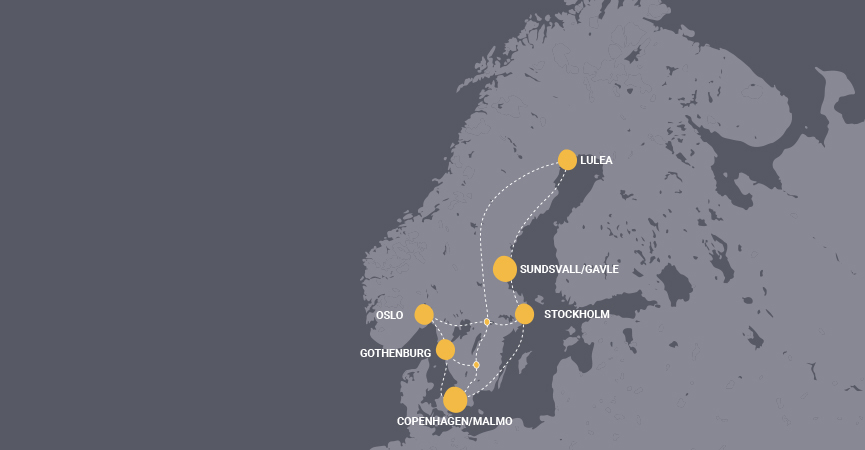
How a distributed IX improves interconnectivity
This blogpost will take a look at the history of distributed IX infrastructure in the Nordics, the technology that makes it possible and the benefits it offers network operators.
History of distributed IX in the Nordics
Interconnecting the Nordics across a distributed IX began in 1997 when Netnod established a second Point of Presence for the Netnod IX in Stockholm. More recently, Netnod has deployed distributed IXes across the following regions:
2014: Copenhagen/Malmo - distributed IX across (and underneath!) the Öresund bridge
2016: Oslo
2019: Norway, Sweden and Denmark (though the Remote IX service)
2020: Sundsvall/Gavle - the distributed IX for mid-Sweden
Netnod’s distributed IX model makes it simple for customers to connect and exchange traffic locally. This provides a range of new business and service possibilities for providers together with municipal and regional networks that previously had to take long routes to exchange traffic.
IX technology
Netnod IXes consist of one or two peering LANs located in secure facilities with electricity generators, water cooling and isolation to provide complete protection against electromagnetic impulses. These facilities are connected to colocated sites at major data centres using state-of-the-art Data Centre Interconnect (DCI) equipment from ADVA Optical Networking and the very latest switching technology from Arista.
Netnod has made significant investments to build a scalable DWDM platform enabling the most flexible, cost-effective peering and transport services in the region. In 2019, we became the first IX in the world to offer 400GE ports at multiple IX locations.

At Netnod, we are firm believers in route servers and we make them readily available on all Netnod IXes. By peering with the Netnod route server, you can easily peer with many other networks using just one connection. Almost 70% of the connected networks at Netnod are available through the route servers. Netnod’s route server platform provides support for RPKI (secure routing), standard BGP communities, and a publicly available looking glass.
IX benefits
Instead of backhauling on a transit route to exchange traffic, peering at an IX gives networks improved speed and routing control. This improves performance and lowers latency while also ensuring cost-effective connections. As more networks interconnect locally, the local infrastructure becomes more robust and provides a better experience for all users.
We have seen this development at the Netnod IX Copenhagen, the distributed IX interconnecting Copenhagen and Malmo. Peak traffic there recently hit in excess of 200Gbps making Copenhagen the second busiest exchange in the Nordics after Stockholm and helping to drive the digital transformation of the region.
In Gavle, the new peering switch is connected to the existing switch in Sundsvall giving both existing customers in Sundsvall and new customers in Gavle increased peering possibilities. Together with the Netnod IX route servers there, it is easier than ever for local networks in mid-Sweden to exchange traffic. Since the launch of the distributed Sundsvall/Gavle IX in May 2020, we have already seen a significant increase in traffic and a growing number of networks looking to interconnect locally.
Networks peering at a Netnod IX have access to the full range of Netnod’s interconnection services. These include WDM transport services, enabling point-to-point transport across metro areas and throughout the Nordics, and Netnod’s Remote IX service. Using just one port, and one cross connect, customers can also interconnect across the entire Netnod IX platform accessing multiple routes and peering opportunities with almost 200 networks exchanging more than 2Tbps of traffic across the Nordics.
This is a brief overview of the distributed IX infrastructure interconnecting the Nordics today. At Netnod we are continuously working on developing more effective interconnection solutions to scale with customers’ needs, help grow their networks and offer the most flexible and competitively priced services available. I look forward to sharing the latest developments in future posts.




